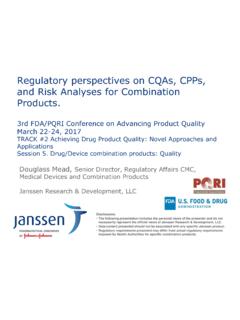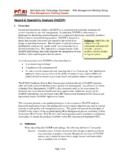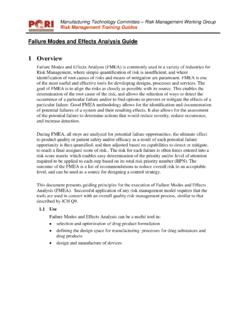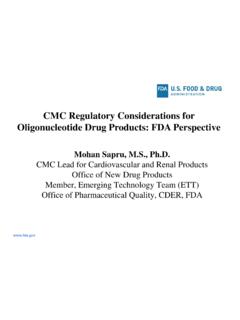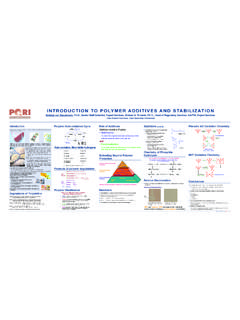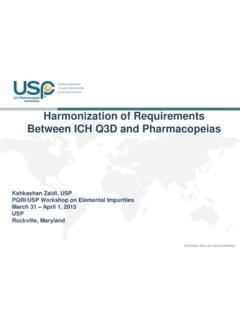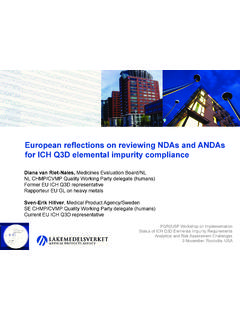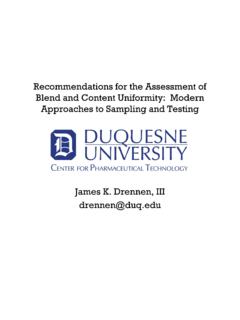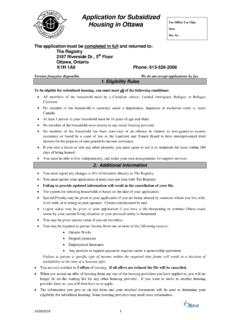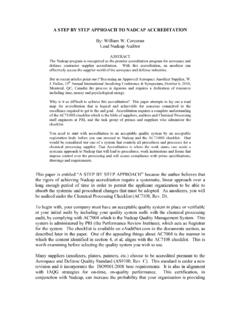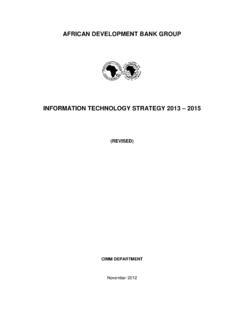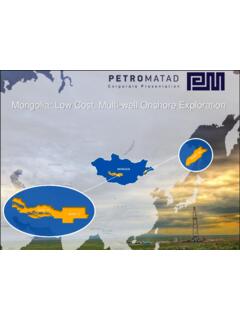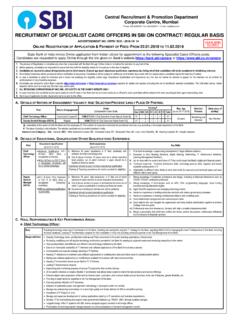Transcription of Managing Change in Manufacturing - PQRI
1 Managing Change in ManufacturingNigel HamiltonPQRI/FDA Process Drift Conference, Maryland, Washington DC1st 3rdDecember 2010 King Henry VIII Flagship Mary Rose Launched 1509 Numerous improvements More guns (and ports) Heavier guns Sunk 1545 Fighting the French! Managing Change in ManufacturingLink to ICH Q10 Types of Product and Process changeImportance of knowledge to effective Change managementConsider another high tech industryKey MessagesProduct Lifecycle (ICH Q10)ICH Q10 Pharmaceutical Quality SystemGMPP harmaceutical DevelopmentCommercialManufacturingDiscon tinuationTechnology TransferInvestigational productsManagement ResponsibilitiesProcess Performance & Product Quality Monitoring SystemCorrective Action / Preventive Action (CAPA)
2 System Change Management SystemManagement ReviewPQSelementsKnowledge ManagementQuality Risk ManagementEnablersChange ManagementChanges WILL happen throughout the product lifecycleProactivelydue to business or technical reasonsPart of continual improvement initiativesReactivelydriven as part of CAPADue to deviations, OOS, batch rejectionsThe Pharmaceutical Quality System must include a robustchange management systemUse of knowledge and Quality Risk ManagementChanges -Forced or Voluntary ?Some things must bechanged where we have no optionSupplier stops tradingCustomer complaintsOther things can bechanged where we do have an optionEquipment modernisation / Software upgradeQC test method improvementContinual improvement initiativesWe always need to consider the risk versus benefit of each changeBut the biggest risk by far is an uncontrolled changeSmall changes do not always equal low riskTypes of Product and Process ChangeNature of ChangeControlledChangeUncontrolledChange Managed through formal Change control systemProduct Change ( excipient supplier Change ) Process Change ( equipment upgrade)
3 Unnoticed Change -process drift (over time period or number of batches) Uncontrolled Change ( fraud, accident, or error) Continual Improvement and Change Management1. Continual Improvement2. Process Change3. Process ControlPart of the company cultureChange verified as successfulControlled via robust Change management systemTypical Change Management Process MapChange Identification & CharacterisationImplementation of ChangeChange Impact assessmentAction PlanExecution of technical stepsChange Approval(With or without regulatory approval as necessary)Review of effectivenessNo Change to performDescribed in the company PQSWhat data needs to be developed?
4 What is the potential impact?How it will be measured?Estimate risk ( severity, probability, detectability)posed by a proposed changeDocuments the Change , the results, and QU approvalChange Management: Importance of KnowledgeEffective ChangeKnowledgeIncreased knowledge increases chances of successful changeIncreased knowledge comes fromExperience!Increased Product UnderstandingIncreased Process UnderstandingBut how do we systematically capture such product and process understanding? Change Management: Importance of KnowledgeEffective ChangeKnowledgeDevelopment ReportTech TransferReportInitial Validation ReportContinuous VerificationInternal and external events (deviations, complaints)Annual Product ReviewsChange Management: Importance of KnowledgeBut these key pieces of dataNeed to be available to the Manufacturing siteUsed as reference data when assessing changesThe people need to be trained and educated as appropriate for their daily workOn the most recently available the background/reasons for changesChange Management: Traditional Process ValidationKnowledge/ Process drift?
5 Materials? Equipment? People? Procedures Systems? Lack of interest?validation batchesChange Management: Continuous VerificationKnowledge/ Process More batch data Trend monitoring More knowledgeContinuous Verification: Process MonitoringProcess Tracking and TrendingAddress trends before they become problemsVerify changes are successfulProduct Quality MonitoringAnalyze critical process parameters & critical quality attributes in the control strategyReduce sources of variationIf it brings quality improvementControl Limits: Derived from Historical Release Data100908070605040302010110710610510410 3102101100999897969594 IndexAssayLCL = = Control Chart of Assay.
6 3 new batchesASSAY = Spec: - -50510152025303540 AGE92949698100102104106 ASSAYS pecsTrend LimitsTrend Limits: Derived from Historical Stability DataTypes of Product and Process ChangeNature of ChangeControlledChangeUncontrolledChange Managed through formal Change control systemProduct Change ( excipient supplier Change ) Process Change ( equipment upgrade) Unnoticed Change -process drift (over time period or number of batches) Uncontrolled Change ( fraud, accident, or error) Example of Uncontrolled Change Unnoticed Process DriftRaw Material variability is one major of pharmaceutical process variationCan give rise to process variation even if raw material is within the agreed specification limitsThis natural variability needs to be understood and controlledExample of Uncontrolled Change Fraud/Malpractice Fraudulent Change of raw material (glycerin, heparin, etc)
7 Improved fingerprinting of high risk susceptible raw materialsSupplier audits and controlsOperator decides to wash machine parts at higher temperature 80oC instead of 50oC for a shorter time period without Change controlThought he was doing continual improvement!His heart was in the right place!Always ask: Technical, System, or Management issueExample of Uncontrolled Change Accident or ErrorAccident/Errors Examples Operator accidentally drops scissors into the product during processingFirst time using a new isolatorProcess design had not been thought throughOperator accidentally selects wrong cleaning cycleMaster batch record updated as part of changeNew cycle entered into CIP as part of old cycle was not deletedNailing Down the ProcessesNeed to nail down process to avoid changes via accident or errorRemove possibility for process parameters to be changed by malpractice.
8 Accident or machine parts washer Use of FMEA when considering process design, process scissors in product, Need to train everyone on Change control procedureGood Change control will be as good as the training and educationInclude training on serious consequences of uncontrolled changeBuild it into the culture of the company/siteNASA Space Shuttle Program Process Control Standards & Practices Handbook40 pages mention Change 58 times!!Standard 1: Detect and eliminate process variability and uncoordinated methods for early detection of changes in materials, parts, or assembliesStandard 3: Understand and reduce process risksUnderstand potential risk when a Change is implementedNASA Space Shuttle Program Process Control Standards & Practices HandbookStandard 6: Promote process control awareness.
9 Understand and report process for reporting changes to processes, materials, methods, etc. to the appropriate individuals for analysis and potential impactsStandard 7: Identify and evaluate changes to equipment and the baseline and manage and control any changes to that baselineAnalyze changes for potential impacts to risk, safety, changes are coordinated, reviewed, and approved by authorized individualsMaintain documentation of changesSummary: Management culture is key to effective Change controlManagers must lead by exampleCreate and maintain strong Change control system and cultureManagement support for problem identification, reporting, and continual improvementPeople must be trained and educatedon the Change control systemEnsure QRM tools used as part of the Change control when appropriateNail down process to avoid Change by accident or errorAre issues technical, system, or management related Summary.
10 Knowledge is key to effective Change controlPeople must systematically obtain and utilise the knowledge available to them as part of Change controlTo make the best judgements of risk (QRM) Small changes do not always equal low risk!To be able to demonstrate scientific and logical justificationAnd to continually add to the product and process knowledg
